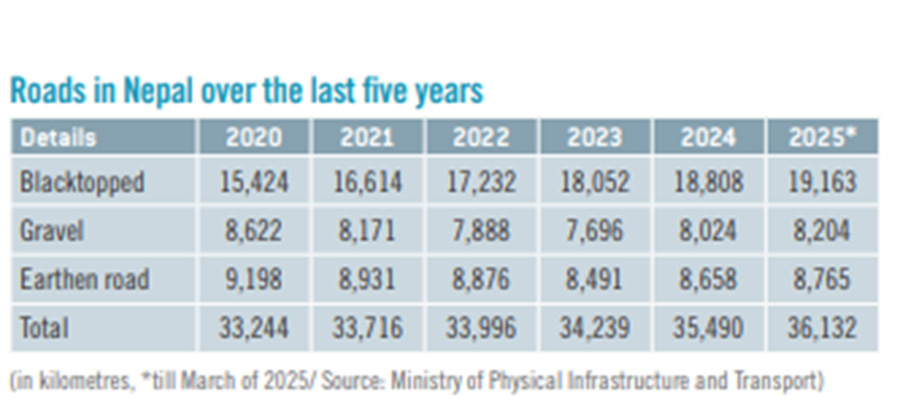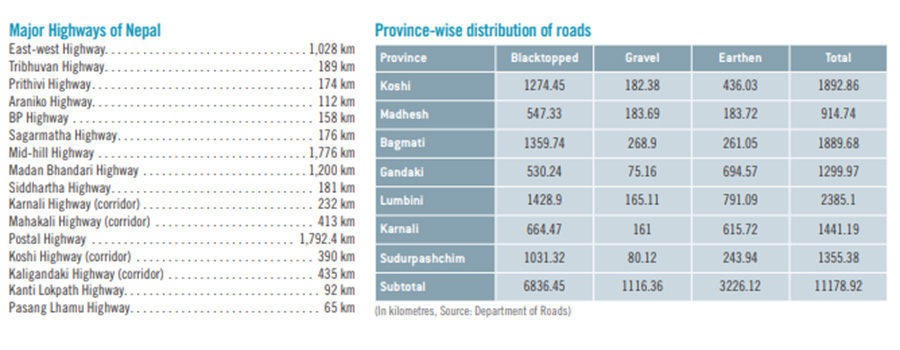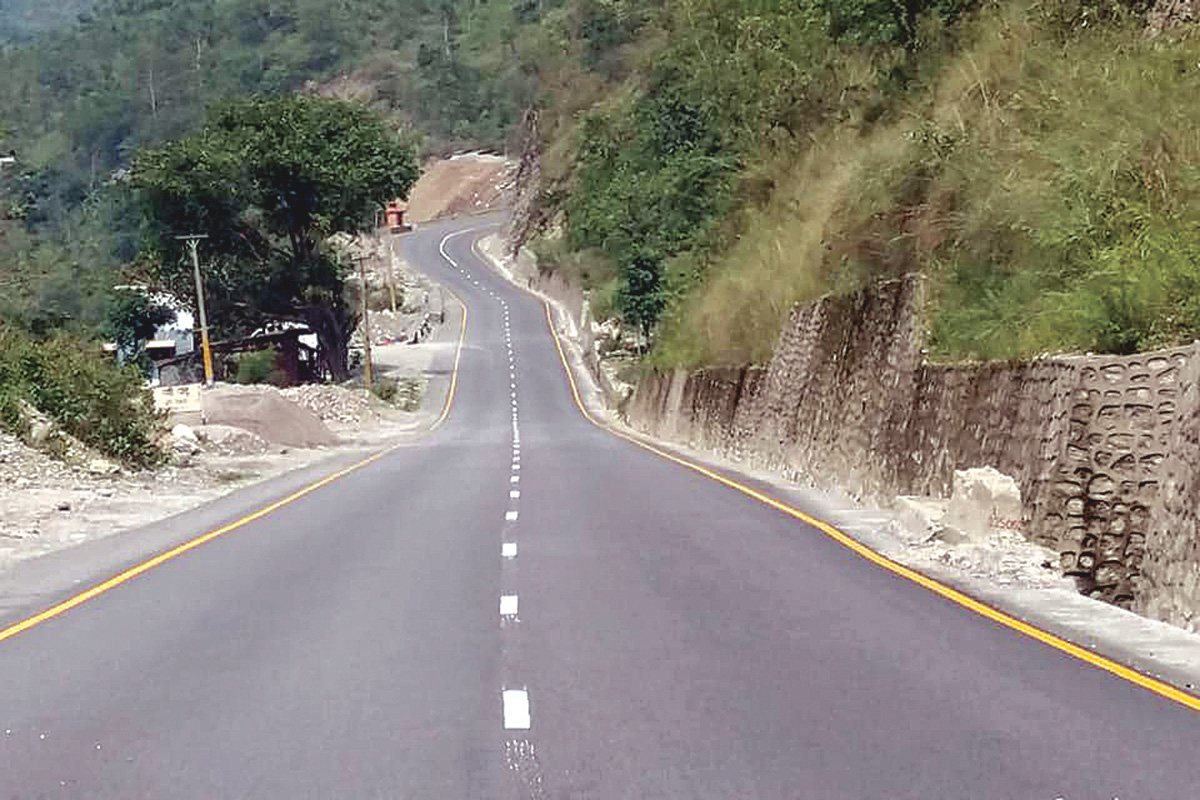-1758006240.jpg)
Roads, a fundamental infrastructure, are widely recognised as the backbone of the transportation system and a lifeline for development. Over the years, the expansion of road networks has accelerated the country’s development by facilitating trade, creating market centres, increasing mobility and contributing to the development of other infrastructures and the well-being of the population. Although robust internal and cross-border connectivity are national development priorities, the government develops, upgrades and maintains roads based on priority due to a lack of sufficient resources.
Roads represent the largest infrastructure stock and receive the highest budget allocation for physical infrastructure. In Fiscal Year 2025/26, the government has allocated Rs 159.82 billion for roads and bridges. Nevertheless, a lack of adequate resources and execution capacity hinders the achievement of desired outcomes.

Road Technologies & Implementation
Over the years, Nepal has not only expanded its road networks but also upgraded them with modern technologies. However, compared to global standards, Nepal is still lagging in road development. The country is in the initial phase of implementing tunnel roads and flyovers. The Nagdhunga tunnel, the first tunnel road project, links Nagdhunga to Sisnekhola and shortens the distance by 2.6 km. Additionally, a half-kilometre-long overpass was recently constructed in Gwarko, Lalitpur, to ease traffic flow, marking the first overpass in the country’s history of road development.
The Kathmandu-Terai Fast Track Project, hailed as a national pride project, includes high-rise bridges, flyovers and tunnels. The Nepali Army is developing this expressway, which is expected to be completed by April 2027.
Despite these efforts, the implementation of road projects faces numerous challenges. Roads are complex, cost-intensive and labour-intensive construction works. According to the Department of Roads, a multitude of issues impede the implementation of road projects in Nepal. These challenges include site clearance problems such as land acquisition, the removal of structures, forest clearance and a lack of proper environmental impact assessments. The procurement process is also fraught with difficulties, including the lengthy preparation of bidding documents, a slow overall process, a mandatory 45-day notice period for International Competitive Bidding on projects over Rs. 5 billion, and complications arising from bid evaluation, disputes and court cases.
Further hindrances arise during site mobilisation. Main contractors often hire subcontractors and are simultaneously involved in multiple projects, leading to a shortage of equipment, skilled human resources and labour to complete work in a timely manner. The capacity of contractors is also constrained by their limited ability to invest in advanced equipment and technology, including for bridge and tunnel construction. Low bidding is a major procurement problem, as contractors may later seek variation orders that are above the authority of project chiefs and require Cabinet approval, leading to delays and potential penalties for those who prepared the initial cost estimations.
Other significant issues include a lack of smooth supply of construction materials and a shortage of labour, both of which affect project timelines. Disputes with locals, protests and obstructions also occur when local people make undue demands or when project implementers fail to meet community requirements outlined in environmental impact assessment reports. The increasing frequency and intensity of natural disasters in recent years obstruct construction activities and the limited fair-weather window for road construction further restricts the time available for work. In some cases, natural calamities and unforeseen circumstances lead to the application of force majeure.
The splitting of bulk contracts, particularly for feeder roads managed by sub-national governments, is another challenge. Breaking contracts into small sections to make them eligible for user/consumer groups can dampen the quality and standards of these roads. Corruption is a persistent and significant challenge within the physical infrastructure sector.
Finally, maintenance delays are caused by slow resource release from the Roads Board Nepal (RBN) to the Department of Roads (DoR) and a lack of institutional coordination, in addition to the aforementioned capacity constraints of contractors and raw material supply issues. A prolonged delay in the settlement of outstanding dues to contractors by the government also contributes to a trust deficit.
Roads & Resilience
Nepal’s national highways and strategic road networks are the backbone of the country’s transportation system. With the shift to federalism, the federal government now holds the responsibility for the development and maintenance of these roads, including those that connect two provinces. The Department of Roads (DoR), a specialised agency under the Ministry of Physical Infrastructure and Transport, is tasked with construction and quality inspection. The DoR is currently prioritising the expansion of the road network to establish strong connectivity, which in turn is expected to spur economic growth and improve livelihoods.
In recent years, the government has made significant progress in developing several north-south corridors. These include the Koshi (Kimathanka to Itahari), Kaligandaki (Korala, Mustang to Nawalparasi), Karnali (Hilsa to Surkhet), and Mahakali (Tinker, Darchula to Kanchanpur) corridors. Upon their completion, these will create full-fledged highways connecting the north (China) and south (India) of the country, complementing the existing east-west highway. Nepal’s east-west highway is part of the larger Asian Highway network, specifically routes AH2 and AH42, which also connect India and China.

Building roads in Nepal’s rugged mountainous terrain presents a significant challenge. Despite these difficulties, the country successfully connected all district headquarters with all-weather roads by linking Dolpa in 2018 and Humla in 2020. However, the frequent damage to these roads from climate-induced disasters has made rehabilitation an immense task.
According to Tulasi Sitaula, a transport specialist and former secretary of the Ministry of Physical Infrastructure and Transport, “Poor road conditions have significantly increased logistics costs for trade and introduced unpredictability.” He added that the growing frequency and intensity of natural disasters lead to accidents, raise construction and maintenance costs, and hinder economic activities and people’s mobility, thereby affecting their access to essential services like health, education and banking. To combat this, experts have recommended adopting resilient solutions such as using rockfall netting in combination with planting bamboo and other landslide-reducing vegetation to minimise damage and losses.
Road infrastructure spanning 26-32 kilometres in the Terai region is causing multiple problems, including waterlogging and inundation. “With the Postal Highway and the east-west railway under construction alongside the existing east-west highway, we must be concerned about the interests of multiple mega road and rail projects at the foothills of the Terai within a 30-km breadth,” noted Mahesh Acharya, a former minister. He further remarked that infrastructure should be used for improving livelihoods and accelerating economic development and growth, not for creating human misery by inviting crises and disasters.
Earthen Roads & Rural Agricultural Roads
In recent years, local municipalities and rural municipalities have been constructing roads without proper feasibility studies or detailed designs, with contractors often dictating the layout. The rampant construction of these earthen roads is causing multiple disasters and drying up water sources. Last year, on July 12, two public buses plunged into the Trishuli River near Simaltal in Chitwan. A probe panel confirmed that a mudslide onto the national highway, caused by the extensive road construction on nearby hillsides by local municipalities, led to the accident.
Disaster management experts have stated that this uncontrolled construction of local and rural roads intensifies the southward flow of soil and minerals from steep hills during the monsoon season. Ultimately, this rampant construction triggers landslide risks and has an adverse impact, rather than serving the intended purpose of improving market access for agricultural goods from the hills.
Quality Inspection
The quality inspection of locally funded roads is weak and often misused. The eleventh-hour rush to spend funds at the end of the fiscal year frequently raises concerns about the quality of road construction and maintenance. Although oversight agencies, including parliamentary panels, have warned the government to control this misuse of public funds, their intervention to prevent collusion between politicians and contractors is largely insufficient. While payment approvals require a quality inspection certificate, political and contractor influence often pressures state mechanisms to act in favour of contractors.
In contrast, aid-funded roads adhere to all standards. According to Sushil Babu Dhakal, a former Director General of the Department of Roads, funding from multilateral donors like the Asian Development Bank (ADB) and the World Bank cannot be secured without fully complying with their quality standards. Currently, ADB and World Bank are involved in the upgrade of various sections of the east-west highway, as well as other projects, ensuring that these roads meet international benchmarks.
Maintenance & Roads Board Nepal (RBN)

Under the Road Boards Act, Roads Board Nepal (RBN) is authorised to collect a levy for road maintenance. The government, with RBN’s permission, currently levies a fee of Rs 4 on petrol and Rs 2 on diesel, along with other charges like road permit fees and toll gate fees. These collections have accumulated to over Rs 100 billion in the government treasury.
According to Ganesh Bahadur KC, Executive Director of RBN, three types of maintenance are performed: routine, recurrent, periodic and rehabilitation. For the upcoming fiscal year, Rs 9.98 billion is needed for the maintenance of federal roads. However, the allocated budget is only Rs 4.29 billion, which is severely insufficient. The RBN carries out its maintenance work through Road Divisions at the federal level and through municipalities and rural municipalities at the local level. KC has stressed that it will be difficult to provide adequate funds for maintenance unless RBN is given full authority to spend the collected levy, rather than having to seek funds from the Ministry of Finance.
Leveraging PPP for Infrastructure
Given the resource constraints and delays faced by the government in implementing infrastructure projects, experts have advised using public-private partnerships (PPP) to accelerate the development of roads, bridges, flyovers and tunnels. Sushil Gyewali, CEO of Investment Board Nepal, cited neighbouring India’s success in transforming its infrastructure landscape through a hybrid annuity model for highways, bridges and tunnels as a potential model for Nepal. He emphasised that PPPs could be a viable path for Nepal’s infrastructure development.



-1765706286.jpg)
-1765699753.jpg)

